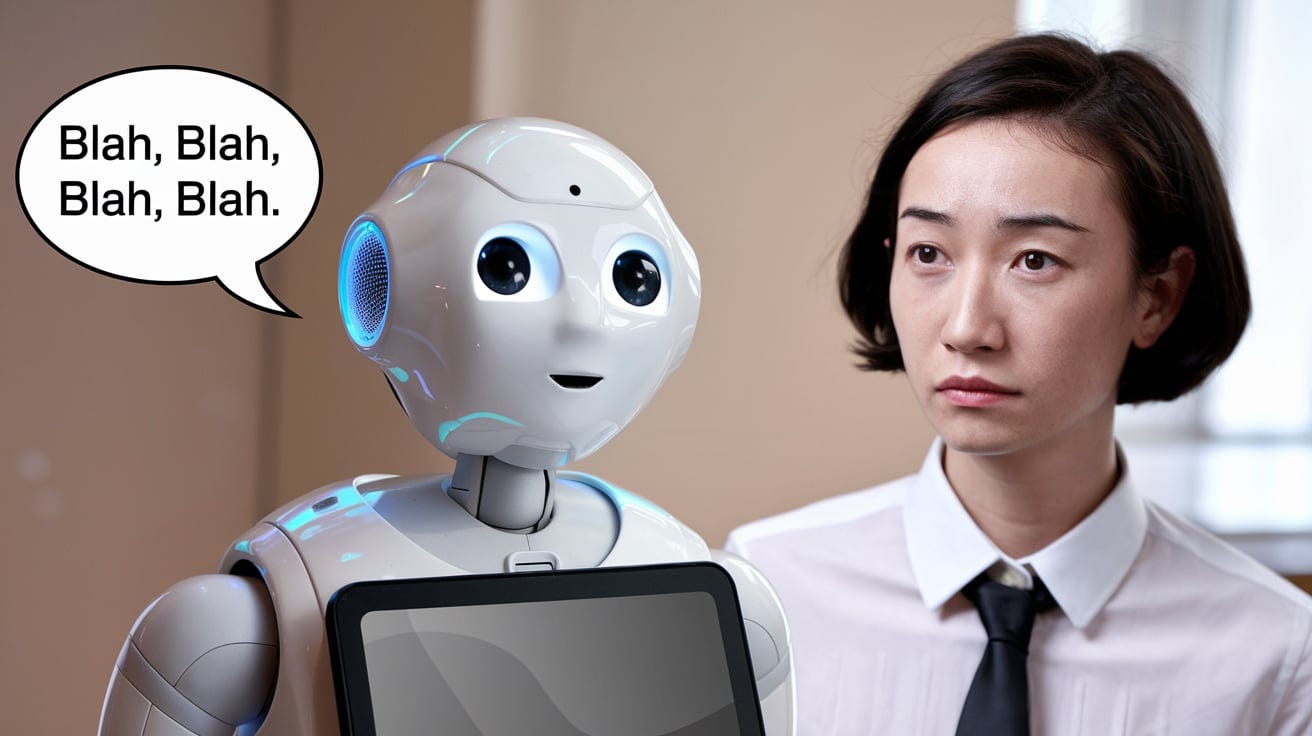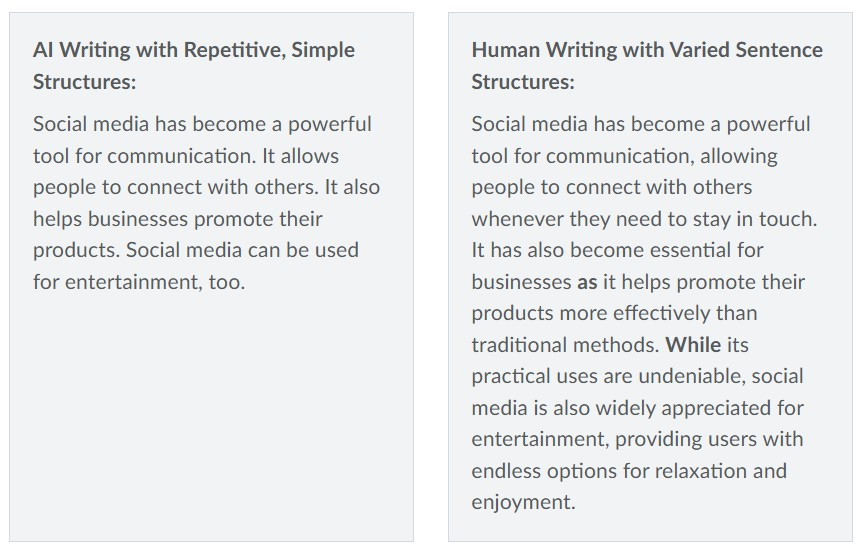Recognizing AI Structures in Writing
This is a page we made for our writing students in our Composition II course
This is a page we just completed for this semester’s Composition II Course. We wrote it so that our students can recognize AI structures in the writing they encounter, so they don’t pick up bad habits. They are surrounded by AI, and we don’t want them to start writing like bots!
We are proponents for using AI in writing, so this page should never be construed by anyone as one dedicated to prevent “cheating” with AI. That is not its purpose.
We believe teachers are teachers, we aren’t police! 🚓
Avoiding AI Structures
It happens to all of us. There you are, reading along, and suddenly you say to yourself, "Wait, this sounds like AI." A lot of the time we know what AI writing sounds like, but it is hard to define what, exactly, makes it suspiciously non-human.
In general, AI-writing is predictable, average, and boring. AI-generated sentences follow the same rhythm: a simple statement followed by another. As writers, we want to bring vibrancy and character to our work—something that ChatGPT, for all its cleverness, often struggles to do.
But watch out! Even if you are writing your own work, you have probably read so much AI-generated writing, that you may have lapsed into the same boring rhythm--sometimes to the extent that your human-created, work sounds more robot than human!
Let’s explore how to avoid falling into the trap of repetitive sentence structures by adding diversity and flair to your writing. But first, let's try to identify what it is that makes us suspect something is written by AI.
Consider these examples of a ChatGPT generated paragraph vs. a paragraph written in a personal, distinct voice:
Syntactic Surprises🎁 Are Quintessentially Human
Generative AI writing usually lacks syntactic surprises. Human writers sometimes use unusual word orders or sentence inversions for emphasis or stylistic effect. Humans have an infinite number of ways to express the same message, even mixing in a sarcastic phrase or a pun, just for fun. We love alliteration, unusual rhythms, and tongue-tangling combinations.
AI language is "eerily 'regular'" because it is the result of averaging many different original and interesting styles into one big unoriginal average style. This results in impeccable grammar, spelling . . . and predictability.
In addition to predictable style, AI has the following unfortunate attributes:
Preference for certain words and phrases: AI chatbots tend to favor certain nouns, such as "journey," "embark," and "realm." They also use complicated words or phrases such as "delve," "nuance," "cutting-edge," and "rich tapestry," even if they don't fit the context or the audience.
Wordiness and lack of meaning: AI chatbots often produce long, vague text with a lack of helpful or actionable guidance. You know those scripted videos with the AI voice? They go round and round and talk and talk and say almost nothing. Yup. That's AI.
Five Common AI Sentence Structures
Poor AI tries so hard to sound like us, but it fails, mostly because it is stuck on simple phrases that it tries to connect in predictable ways. Identifying these patterns is the first step toward breaking free from them and infusing your writing with more personality and variety. Below, we’ll explore five of the most common AI sentence structures to help you spot them in action and learn when and how to mix things up.
1. Simple Sentences
AI-generated writing usually consists of simple statements followed by other simple statements. Simple sentences are a key characteristic of AI's default writing style.
2. Use of a Semicolon
AI generated writing often connects simple phrases by means of a semicolon rather than using conjunctions. Instead of creating a flow of ideas by using conjunctions (aka connectors), semicolons stop us in our tracks.
3. Use of Adverbial Transitions
Use of adverbial transitions such as "however," "albeit," "therefore," etc. are often used in conjunction with a semicolon to connect simple phrases in an attempt at diversity of language structures, which, of course, is almost the same of using a semicolon.
4. Use of a Modifying Phrase at the End of the Sentence
Again, in an attempt to hide its constant use of simple phrases, generative AI tries to add modifying phrases at the end its sentences. Over and over again, it fails miserably at sounding human.
5. Parallel Structure in Lists
OK, so adding a semicolon, an adverbial transition, or a modifying phrase doesn't work in covering up your obvious linguistic simplicity? I know, let's try adding some parallel structures! That'll work, right?
Be Human: Use a Variety of Sentence Structures, but Don't Get Too Far Away from Your Message
While simple sentences can often deliver your message more directly and powerfully, overusing simple sentences leads to a boring, monotonous tone. In contrast, while complex sentence structures can showcase your writing skills, they can sometimes lead to confusion.
To write in a more engaging and personal style, it is important to have a variety of sentence structures and lengths throughout the whole paper, but striking a balance between complexity and clarity is key.
Techniques
✏️Write Adverb Clauses
Here’s a list of seven useful adverbial conjunctions to connect simple sentences:
Although – introduces contrast
Example: "Although the weather was cold, they decided to go for a hike."
Because – explains cause or reason
Example: "She stayed home because she wasn’t feeling well."
Since – indicates time or reason
Example: "Since you arrived early, we can start the meeting now."
While – introduces simultaneity or contrast
Example: "While he prefers coffee, she always drinks tea."
If – introduces a condition
Example: "If it rains tomorrow, we’ll cancel the picnic."
Unless – introduces a negative condition
Example: "You can’t enter the competition unless you register first."
When – indicates time
Example: "When the train arrived, everyone quickly boarded.
✏️Write Adjective Clauses
Use such conjunctions as "who," "which," and "that."
Who (referring to people):
Example: "The teacher, who always encouraged creativity, inspired her students to think outside the box."
Which (referring to things or animals):
Example: "The book, which was left on the table, belongs to the library."
That (referring to people, things, or animals in defining clauses):
Example: "The house that we visited last summer has been sold."
✏️Write Noun Clauses
Use such conjunctions as "how," "what," and "that."
How (indicating manner or way):
Example: "She explained how the machine operates."
What (indicating the thing or things):
Example: "He didn’t know what he was supposed to do."
That (indicating a fact or statement):
Example: "It’s clear that she has worked very hard on the project."
Remember, adding conjunctions not only promotes a personal voice but also facilitates deeper and more complex thought development. By thoughtfully connecting your ideas, you create a more engaging narrative that invites readers to explore your arguments alongside you.
Oh, and that email . . . 📧
When you get an email that starts, "I hope this email finds you well," there is a 95% chance it was written by AI. It's acceptable to generate email with AI, but always make sure you check it for accuracy, AI structures, and this telltale phrase!












Great article!
I think another telltale sign in AI writing is the use of the emdash. The emdash (—) tends to appear frequently in AI-generated text. This likely stems from training data, as some professional writers (fiction and non-fiction) are known for the liberal use of dashes. However (none of the other adverbial conjunctions fit...lol!), most casual human writing uses them sparingly. They simply (Grammarly suggested I remove 'simply' but I didn't) use hyphens (-), commas, or periods. When they do use emdashes, they frequently do so incorrectly or inconsistently.
I have always started my emails with "I hope this email finds you well,", before the advent of this wave of Gen AI.
I need to find a new opening now.